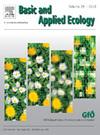Assessing metabarcoding-based identifications for monitoring beetle communities in temperate forests
IF 3.5
2区 环境科学与生态学
Q2 ECOLOGY
引用次数: 0
Abstract
With accelerating global change, there is an urgent need for rapid and comprehensive species monitoring programs to assess the status of insect assemblages; knowledge that is indispensable for the development of strategies that counteract insect declines. With the advent of high-throughput sequencing technologies, DNA metabarcoding has evolved into a particularly useful tool for speedy identification of species from bulk samples. Here, we evaluated the suitability of both tissue- and preservative-based DNA metabarcoding approaches for potential use in large-scale forest insect monitoring initiatives with a focus on beetle communities. For this purpose, we investigated the contents of pitfall (Barber) traps and corresponding cross-window traps for the presence of Coleoptera species. We also compared the performance of three common preservative liquids in terms of species and DNA preservation and determined the optimal time interval for trap replacement. To assess how well the investigated forest beetle community can actually be represented by metabarcoding, we identified ground beetles (Carabidae) of each Barber trap sample using (a) morphological identification; (b) DNA metabarcoding of the homogenised tissues; and (c) DNA metabarcoding of the preservative liquids used in the traps. Finally, we evaluated the influence of the number of DNA extraction and PCR replicates on taxon detection. Even though our study was limited to a single location and peak season, we succeeded in detecting the DNA of 389 mostly plausible beetle species across a total of 54 samples. Effects of preservative liquids were small, although more species were captured by ethanol-filled traps. We further observed an increase in detected beetle species with increasing length of trapping intervals. Overall, we found tissue-based metabarcoding approaches employing a well-designed DNA extraction (and possibly PCR) replication strategy to represent a powerful option for monitoring forest beetles and potentially other insect communities. The preservative-based approach we used needs further optimisation.
基于元条形码的温带森林甲虫群落监测鉴定评估
随着全球气候变化的加速,迫切需要快速和全面的物种监测计划来评估昆虫群落的状况;这些知识对于制定对抗昆虫数量减少的策略是不可或缺的。随着高通量测序技术的出现,DNA元条形码已经发展成为从大量样品中快速鉴定物种的特别有用的工具。在这里,我们评估了基于组织和基于防腐剂的DNA元条形码方法在大规模森林昆虫监测活动中的适用性,重点是甲虫群落。为此,我们调查了陷阱(Barber)和相应的交叉窗陷阱的内容,以了解鞘翅目物种的存在。我们还比较了三种常见的保存液体在物种和DNA保存方面的性能,并确定了陷阱更换的最佳时间间隔。为了评估所调查的森林甲虫群落实际上可以用元条形码表示的程度,我们使用(a)形态学鉴定方法对每个Barber陷阱样本的地面甲虫(Carabidae)进行了鉴定;(b)匀浆组织的DNA元条形码;(c)捕集器所用保存液体的DNA元条形码。最后,我们评估了DNA提取次数和PCR重复次数对分类群检测的影响。尽管我们的研究仅限于单一地点和高峰季节,但我们成功地在总共54个样本中检测了389种最合理的甲虫物种的DNA。保存液体的影响很小,尽管用充满乙醇的捕集器捕获的物种更多。我们进一步观察到,随着捕获间隔时间的延长,检测到的甲虫种类增加。总的来说,我们发现基于组织的元条形码方法采用了设计良好的DNA提取(可能是PCR)复制策略,代表了监测森林甲虫和潜在的其他昆虫群落的强大选择。我们使用的基于防腐剂的方法需要进一步优化。
本文章由计算机程序翻译,如有差异,请以英文原文为准。
求助全文
约1分钟内获得全文
求助全文
来源期刊

Basic and Applied Ecology
环境科学-生态学
CiteScore
6.90
自引率
5.30%
发文量
103
审稿时长
10.6 weeks
期刊介绍:
Basic and Applied Ecology provides a forum in which significant advances and ideas can be rapidly communicated to a wide audience. Basic and Applied Ecology publishes original contributions, perspectives and reviews from all areas of basic and applied ecology. Ecologists from all countries are invited to publish ecological research of international interest in its pages. There is no bias with regard to taxon or geographical area.
 求助内容:
求助内容: 应助结果提醒方式:
应助结果提醒方式:


